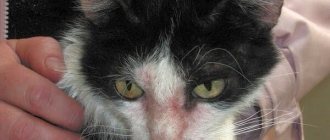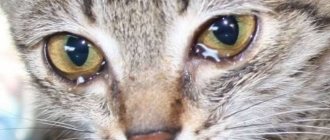The so-called periaucular alopecia (the appearance of characteristic bald patches near the ears) is a common phenomenon in many cats. Other signs of skin pathologies are often absent. Most often, symptoms of alopecia appear in cats with short hair; itching is completely absent.
Alopecia, as a rule, is heterogeneous in nature, covers the entire ear area, and can spread to other areas of the animal’s skin. We will discuss further why this pathology occurs.
Causes of alopecia
The reasons why a cat develops a bald spot behind the ear, or only the tips of the hearing organs are hairless, can be very diverse. It is worth considering the most common among them.
Genetic abnormalities
Hypotrichosis is considered a genetic, inherited disorder. As a rule, it manifests itself at an early age. Kittens remain without fur, and then grow it again.
The pathology is extremely rare and does not pose a threat to the pet’s life. True, it is practically not amenable to therapy. Such cats are not allowed for breeding.
Avitaminosis
The cat's body does not produce vitamin A.
The animal receives it with food. If there is a shortage of this substance, the condition of the coat and skin worsens, and the appearance of baldness is possible.
Obesity
With excess body weight, the sebaceous glands become inflamed and dermatitis develops. Alopecia is also possible.
Due to the fact that the cat cannot provide adequate care for its fur, baldness occurs.
Such a pet needs to be given special food that helps reduce body weight.
Psychological alopecia
Sometimes baldness occurs in animals that are under stress.
When nervous, the cat begins to calm itself down through constant licking. But if you suspect psychogenic alopecia, you should not exclude an allergic reaction, which can also lead to baldness .
Reaction to medications taken
Bald spots in the ear area can appear as a result of taking medications.
If such a reaction occurs, you should contact your veterinarian and replace or completely discontinue the drug.
Helminthiasis
When the body is infected with worms, metabolic processes are disrupted and the immune system is suppressed. A deterioration in the condition of the coat indicates helminthic infestation. In neglected situations, bald spots appear.
Failure of the endocrine system
With endocrine disorders, bald areas also appear. Disturbances in the activity of the thyroid gland, problems with the adrenal glands, sterilization and diabetes can lead to hormonal imbalance.
Infectious alopecia
The appearance of bald areas on the ears is often observed when an infection enters the body. It can affect the respiratory tract, intestines or eyes.
To choose treatment tactics, you must consult a veterinarian.
Lichen
The pathology is caused by fungi and poses a serious danger to people.
The disease manifests itself in the form of bald round areas on which there are remnants of hair (their root part). The skin is covered with scales. The pet suffers from severe itching and scratches the affected areas. Gradually they become larger.
Mechanical factor
This type of baldness is the easiest to eliminate.
Bald spots can appear after a fight with other animals or injury. Special therapy is not required in this case.
Over time, the condition will normalize and new hair will grow.
Ear mites
Ear mites, scientifically known as Otodectes cynotes, can cause severe itching and cause hair loss on cats' ears and head. These mites are easily transmitted to other cats and are sometimes even transmitted to humans, although they cannot survive on humans.
Signs of an ear mite infestation include:
- Rubbing your head
- Trembling in the ears
- Scratches
- Redness
- Hair loss
- Brown waxy growths in the ears
- Unpleasant smell
Ear mites are easily diagnosed using an otoscope. Treatment usually involves thoroughly but gently cleaning the ears and applying veterinarian-recommended medications directly into the canals. It is usually necessary to repeat the treatment for seven to ten days to kill any new hatchlings.
Symptoms You Shouldn't Ignore
If the animal notices the appearance of completely bare areas of the skin or is covered with excessively sparse hair, then it is necessary to consult a doctor. Also of concern are peeling, redness, itching and crusting.
All these symptoms cannot be ignored: there is a high probability that your pet is developing a serious illness.
Fleas
The saliva left behind after a cat is bitten by a flea causes an itchy reaction that makes cats itch like crazy. While hair loss can occur anywhere on the body, the hair on a cat's head, face, and ears are especially vulnerable to hair loss when cats rub against furniture and rugs in an attempt to find some relief. Fleas can be easily identified by their physical presence or by the small droppings they leave behind in your cat's fur. Infestations can be treated with a number of insecticidal products, including sprays, shampoos and spot treatments such as Frontline for cats.
How to help a cat
Treatment is selected taking into account the general health of the pet and the factors that provoked baldness.
Medications
After determining the cause of baldness, certain groups of drugs are prescribed:
Allergy. Immunostimulating and antihistamines are prescribed.- Parasites. They resort to the use of antiparasitic drugs.
- Infection. Antibiotics are used, for example Amoxicillin.
- Stress. Drugs that have a sedative effect are used.
- Lichen. Antifungal agents are prescribed. The most commonly used are Ketoconazole or Griseofulvin. In addition, agents are used that stimulate metabolic processes and support immunity.
- Endocrine system disorders. Hormonal medications are indicated.
Traditional medicine
Resorting to the use of folk remedies is strongly discouraged. Often, when using them, there is a deterioration in the animal’s condition.
In addition to drug therapy, it is worth excluding potential allergens from your pet’s menu and providing him with peace. Self-medication is strictly prohibited .
Acne
Acne can appear due to improper care of your pet, severe stress and emotional distress. Acne can develop into pustules and ulcers, which cause severe pain for your pet and sometimes lead to inflammation.
A complication of acne is folliculitis. It is a swelling around the hair, usually with liquid contents. When touched, the pet experiences pain.
Self-medication and squeezing pimples are not recommended. You can treat rashes with tar soap or shampoo.
How to accurately determine the cause
In order to make an accurate diagnosis, the doctor examines the animal, listens to the owner’s complaints, and takes an anamnesis.
Additional diagnostic procedures may be prescribed:
study of hair follicles;- blood analysis;
- determination of hormone levels;
- skin scraping;
- X-ray;
- Ultrasound.
Allergies
Allergies are usually caused by parasites. Symptoms: baldness in certain areas, itching, spots of different colors. The allergy will go away after eliminating the fleas after 5-6 weeks.
Also, allergies can be due to external irritants and food. Treatment in this case becomes more complicated because identifying the allergen is not easy. Shampoos with hydrocortisone work well as local antiallergic agents.
They give an immediate but short-term effect. Hydrocortisone ointments are used when pets have itching. They are applied to small areas that are inaccessible for licking.
Prevention measures
To avoid hair problems, you need to follow these recommendations:
- choose high-quality food that matches the condition and age of the cat;
Give your pet antihelminthics at intervals of three months;- regularly treat the animal for fleas;
- eliminate all factors that can lead to the development of allergies;
- vaccinate in a timely manner;
- provide your pet with complete care.
Treatment of bald ears in cats
Only a veterinarian can provide full assistance to a cat in such a situation; independent treatment is not the best option here. Only a doctor can determine the disease and formulate a treatment plan.
If your cat's ears are going bald due to allergies, you will have to change the environment a little. Perhaps some flowers will disappear from the apartment interior, and the hostess will have to part with her favorite perfume. To avoid a repeat reaction, it is better for the animal to eat hypoallergenic food.
Bacterial and viral infections are treated with a special set of drugs, a new diet and the introduction of vitamin complexes into the diet.
The effects of emotional turmoil may need to be treated with mood modifier pills. Of course, this is not the best outcome, but the cat owner needs to prepare in advance for such a verdict.
© shutterstock
Demodicosis
Demodicosis is an extremely dangerous disease for a pet. It can lead to the death of a cat instantly, sometimes the owner does not even have time to start treating it. Demodicosis appears due to the bite of ticks, which are numerous in the warm season.
Cats cannot take preventive and protective measures themselves, so they often become their victims. Symptoms: damage to large areas of skin, itching, redness. The worst thing is that if a pet gets sick once, then it becomes a constant source of infection. His offspring will also suffer from demodicosis.
It is important to take preventive measures - treat the skin with products that kill ticks (Bars, Harts). It is also worth using anti-inflammatory drugs (Dexafort, Laurabolin 50) and anti-itch drugs (Stop-itch).
Tail gland hyperplasia
If the tail gland has increased hyperplasia, excessive accumulation of sebaceous secretion appears. It is released and envelops the hair at the point of growth, blocking its further development. Because of this, her hair falls out and areas of baldness appear.
Therapy involves monitoring the problem area. Castration can help cats.
Bald spots on the paws and stomach: photos, causes, advice from veterinarians
A lot has been written here about feeding cats. He has already accumulated it both from old age and from improper feeding. I would remove boiled crucian carp and sausage from the table and choose medicinal professional premium food, or only in nature (but you have to weigh everything with a scale and cook it once a week). Our friends have a 14-year-old cat - the hair was peeling off from the ears and legs, itching until it bled - they fed it haphazardly, after they switched it to normal food, the cat came into divine shape. Here. My point is that animal nutrition is of primary importance for health. Everything is the same as with people.
Yanchik, put the cat on a diet, this is advisable. Try to replace the fish with boiled chicken, or lean beef. Fish, especially river fish, is not suitable for feeding cats, especially at this age. Try to remove sausages altogether, there are a lot of substances that are harmful to people, not just cats. Curdled milk, egg, low-fat cottage cheese, chicken, beef, chicken heart and gizzards, all boiled, but what am I telling you, read our threads about feeding natural and industrial feeds, choose what suits you. It is necessary to have blood analyzed and scraped for culture; without this, who will figure out what to treat the cat for. Consider age, this is also important, because an animal at that age needs, just like a person, a certain diet and care.
Thank you very much for the advice) we will definitely listen: smile:
Eczema
Eczema is an unpredictable disease.
Appears due to many factors, including:
- Severe skin contamination with parasites, dirt, bacteria;
- Improper wearing of collars and synthetic clothing for cats;
- Complication of any disease (pathology of the nervous system, kidney disease, stomach and liver).
The main symptom is a weeping surface of the skin. Scratching causes knots and redness to form. The cat is rapidly losing weight, has a fever and kidney problems.
For diagnostic purposes, the veterinarian will take a skin scraping to rule out the possibility of other diseases. Afterwards he should prescribe antihistamines. You should not try to treat your cat without a doctor, as complications may develop.
Diagnosis of the disease
If adult family members or your pediatrician notice signs of alopecia, you need to understand why your hair is thinning. For this purpose, extensive diagnostics are carried out. To treat alopecia, a child should first visit the following pediatric specialists:
- dermatologist;
- trichologist;
- endocrinologist;
- gastroenterologist;
- neurologist.
These doctors will prescribe a series of examinations to determine the cause of the pathology:
- Gastrointestinal examination. It may include tests for Helicobacter pylori (a stomach bacterium that causes gastritis) using PCR and ELISA methods, stool analysis for dysbacteriosis, ultrasound of the abdominal organs, as well as fibrogastroduodenoscopy (FGDS).
- An endocrinologist may prescribe a blood test for the level of thyroid hormones (AT, TSH, etc.), cortisol, the level of ionized calcium, and ultrasound of the thyroid gland.
- To determine the microelement status of a child, a spectral study of hair and blood is performed to determine the content of microelements.
- ELISA diagnostics allows you to detect antibodies to herpes, hemolytic streptococcus, helminths, Giardia, and fungi.
- The trichologist prescribes a trichogram, computer diagnostics of the scalp, and phototrichogram.
- In clinically unclear cases, a scalp biopsy is performed followed by histology. This is necessary to exclude cicatricial alopecia, which is a symptom of lichen planus and systemic lupus erythematosus.
- If there is doubt about the diagnosis, the child may be referred for consultation to a mycologist.
- Rheoencephalography is indicated for common forms of baldness; it allows one to exclude disturbances in blood flow in the cerebral veins.











